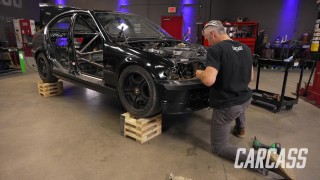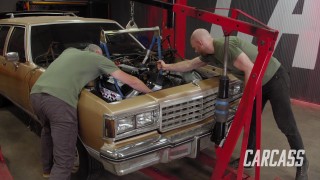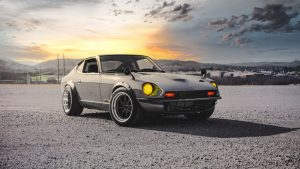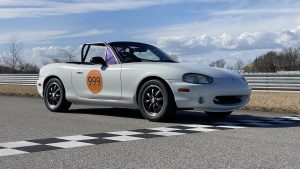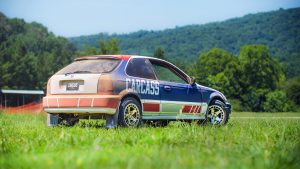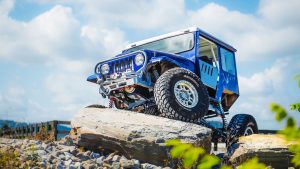Carcass Featured Projects
Carcass Builds
Want more content like this?
Join the PowerNation Email NewsletterEpisode Transcript
[ Jeremy ] You're watching Powernation!
[ Jeremy ] Today on Carcass we show you how to measure for a driveshaft and install some custom wheels and tires. [ Jimmy ] We'll also do some exterior modifications to our Tahoe. So stick around! [ Music ] [ engine revving ] [ Music ] [ Jimmy ] Hey everybody, welcome to Carcass. We have our Tahoe in the shop and we already have our ATK crate engine installed along with a brake upgrade from Powerstop, which we did on a set of GMT-800 spindles because we did want the bigger, better brakes and we wanted to lower this thing a little bit to give it a nice stance. We also have a few more things to check off the list today. [ Jeremy ] And to get moving forward with that list what we're gonna do is mount up a set of custom wheels and tires. We're gonna do some exterior mods around the truck to make it look a little bit better. But first things first is we have to measure for a custom driveshaft cause we went from four wheel drive down to two wheel drive. Since we ditched the four wheel drive transmission and transfer case the stock driveshaft for our Tahoe will not work. We're actually gonna need a longer one. Believe it or not this two door Tahoe does not share the same chassis as the short bed regular cab pickups. These are actually a little bit shorter. Let me get this thing up in the air. We'll grab a tape measure and take some measurements. [ Music ] When ordering a custom driveshaft you're gonna have to know some very specific information. You're gonna have to know the spline count of your output shaft. You're gonna have to know the U-joint size of your pinion yoke. Most importantly you're gonna have to know the length or measurement for your driveshaft. To do that we're gonna use a very common method of measuring. We're gonna put the tape on the end of the output shaft and then we're gonna measure to the face of the pinion yoke. That's about 53 and three-eighths. Let's go over what type of driveshafts you can run in your vehicles. You can run something like a carbon fiber driveshaft. That's what we ran in our Road Course Camaro because we had high horsepower and we were looking for the weight savings. You can run something like an aluminum driveshaft. These are most commonly found I your later model production vehicles, and you can also run your standard steel driveshafts. Something to convey to your driveshaft builder is your horsepower range and the physical size of these because they are underneath your car and these do travel up and down. So you need to pay attention to how big they are. For vehicles that have a lot of suspension movement you can run a driveshaft like this. This has two U-joints on one side. This is a double cardan driveshaft. Something that's more commonly found in your Jeeps and your lifted trucks. Once you figure out what you need you can jump onto Summit Racing's website, plug in some numbers, and order what you want from there. Now there's one more thing that we do need to be concerned with and that's the U-joint size on your pinion yoke that's on your rear axle. So let's go over how you figure out what U-joint you need to use. [ Jimmy ] To figure out what U-joint you need for your new driveshaft is a pretty straightforward process, and if you have the stock driveshaft available like we do for our Tahoe it's as easy as measuring the diameter of the cap and then measuring the width of the U-joint itself and cross referencing these measurements with a table to figure out what U-joint we have. If you don't have the driveshaft available but you know what rear end you're gonna run. A common one is a Ford nine inch. Then you can measure the width across the machine surfaces of the yoke and then measure the diameter of the saddle portion itself. There are a few different styles of U-joints to fit many different applications, and there are even combination U-joints that will take you from a smaller size to a bigger size if necessary. The way U-joints are retained are by way of snap rings. First style looks something like this. Over here on this yoke you can see there is a grove machined into it, and the rings hold the U-joint on the outside. The other style looks more like a C-shape, which will fit into a groove machined into the cap. Then there's a machined surface on the interior side of the yoke to hold everything together. You might even find a U-joint that accepts both styles of clips. It just depends on what you're looking for. The most common sizes of U-joints are 13-10, 13-30, and for high horsepower applications 13-50 seems to be the most common. One other thing to consider here is that some U-joints have accommodations for grease zerks but people tend to stay away from these for performance applications because they are thought to be weaker and can fail prematurely. For our Tahoe I know that we need a 13-30 U-joint but a couple of minutes with your caliper and you'll be well on your way to getting your driveshaft made. [ Jeremy ] Coming up, we prep our big 20 inch wheels so we can get some paint on them and get them on the Tahoe.
[ Jimmy ] Welcome back everybody. We're just getting these wheels prepped for the newest addition to look of our Tahoe. [ Jeremy ] These are 20 by 9 inch solid steel wheels. We got these from Summit Racing. Jimmy and I really like the look of this solid steel wheel. We ordered these in the bare metal finish. So we've got to get them prepped, cleaned up a little bit, get some primer on them. Then we'll move on to paint. What we're trying to accomplish here is we've got to clean up all the areas where the two pieces were welded together. It's got a bunch of dirt, and debris, and dust in here from the welding process. Also on the outside where they did weld the two pieces together there's a bunch of welding slag where the penetration came through. So we've got to get rid of that as well. What we're gonna be doing here is using some Scotchbrite to clean everything up. We'll hit it with some wax and grease remover or some type of a cleaner, get some good etches in here, and then we'll shoot some primer. [ Music ]
[ Music ]
[ Music ] [ liquid sloshing ]
[ Music ] [ Jimmy ] Now that we're over here we're gonna use a little bit of acetone and try to clean off the wheels. Even from just that little bit of sanding with the scuff pads the wheels come out pretty dirty. So we're gonna get all of that off before we move any further. [ Music ]
[ Music ]
[ Music ] What I'm doing now is spraying some self-etch primer. This is gonna allow everything to just bite from here on out for the paint and stuff. So we'll get this down on the inside, the outside, and the in between and then move on to paint. [ aerosol can hissing ] [ Music ] [ exhaust fans humming ] [ Music ] [ exhaust fans humming ] [ Music ] [ exhaust fans humming ] Jimmy ] Now that our primer has had some time to dry we're gonna hit with some wheel paint. The color is graphite. [ exhaust fans humming ] [ Music ] [ exhaust fans humming ] [ Music ] [ exhaust fans humming ] [ Music ]
[ Music ] [ exhaust fans humming ] [ Music ]
[ Jimmy ] We got our wheels painted and we had them baking in the paint booth to make sure that they were fully cured. Now it's time to put some tires on it. We've got General GMax AS-07s in a 275/40-20. [ Music ] [ squeaking ] [ Jimmy ] The AS-07 is an all season tire that will handle any type of road conditions that our Tahoe will see. These tires feature best in class wet and dry braking and snow traction. Our truck will be a comfortable cruiser and these tires deliver low road noise with long lasting tread wear. Rain or shine the General GMax AS-07 will keep the Tahoe attached to the pavement with a comfortable ride. [ Jeremy ] Coming up, we show you how to refresh your faded out fender flares.
[ Jeremy ] Hey guys, welcome back. Now with all the work we've done underneath the hood and to the suspension on our two door Tahoe we want to spruce up the exterior and we're gonna do a couple of easy things to kind make this truck look new and fresh. We're gonna be starting with these fender flares here. These are made out of an a-b-s plastic, and the u/v likes to really pound on these and make them look crummy and make the truck look crummy. You can see somebody has already spray painted this but in the back this is mostly commonly what they look like. They're sun faded and bleached out and they just make the truck look old and tired. So what we're gonna do is go over and easy way to refresh this stuff. We're actually gonna do it right here on the truck. We're not even gonna take them off. The first step and most important step to doing all of this we are gonna wash this with some warm, soapy water. [ Music ]
[ Music ] We hit this thing with some compressed air just to speed up the process. The next step here is to mask off the area, or at least around the area that we're gonna be working cause we're gonna go into sanding and doing a little bit of body work. So we've got the paper and the tape down here. One thing to note I did run a second line of tape right here on the edge. That way as we're sanding just keeps us from getting in and touching off of the paint. We don't want to put any scratches up there. To get started here I've got two pieces of 180 grit. These are like the sticky pads, back to back. I'll go ahead and scuff all this down. Then we'll get ready for some body work. [ sandpaper scratching ] [ compressed air hissing ] [ Jeremy ] So let's talk about what we're doing. From the sunlight hitting this a-b-s plastic it's put a bunch of pin holes or divots in this face and this face over here. So what we're going to do is mix up a little bit of glaze, which is like a body filler but a lot thinner. Then we're gonna glaze over the top of these spots, get everything smoothed out, and then we'll move on to primer. Like I said, what we're gonna be using to fill in all those little imperfections is some glazing putty or metal glaze. This is quite a bit thinner than your regular auto body shop fillers or mud as they call it. We'll just spread this out here on the mixing pad, get a little bit of hardener in it, go back over to the truck, and get some on there. [ Music ] Really want to work this in very, very good. Make sure that hardener gets into all of this. Doing something like this it helps to push onto the paddle. Then if you need to come back and straighten something out don't start with a perfectly clean paddle. Put a little bit of filler on there. It helps you smooth everything out as you pull it. What I'm sanding with now is 180 or 180 grit I should say on a soft block. Probably gonna end up sanding most of this off of here. Basically we're just looking to fill in all of those little pin holes. Another big plus to the glazing putty is it actually sands really nice, really easy. You don't have to put a lot of effort into it. When you guys are doing body work like this if you're gonna try to blend your mud work into the rest of the panel what you're looking for a good blend is this variation in color. You can see that it's getting lighter in here or technically darker. It's cause we're sanding through the mud and getting into the black of the fender flare. If you were to come and prime over the top of that you wouldn't be able to see these blend lines. That's something that we're kinda going for. Again was going to sand this until most of it's off. You can see we're starting to get there already. You can see the black come through here. So we're close. What we used to straighten this panel out is 180 grit sandpaper. The idea here is to get this into a high build primer or a 2-K primer. So we don't want that to have to do a lot of work filling in sand scratches. Even the 180 isn't all that deep. We're gonna take it one step further. We'll just kinda hit this with some 220 and get rid of those scratches so the primer doesn't have to work so hard. So we have it sanded with 220. I went ahead and used compressed air and blew it all off, and I masked it off as well. Now we're gonna be spraying some 2-K high build primer. We're just mainly gonna focus over the areas that have the mud or body work. Get some of this on here, a couple of coats, and we'll build this up. [ aerosol can hissing ] [ Jeremy ] So the primer has had plenty of time to dry. So we're gonna go ahead and hit it with some 400. Now we're not trying to straighten anything out at this point. We're just trying to smooth it out so we can get some color on it. [ sandpaper scratching ] [ Music ] [ Jeremy ] Last step is to tack it off and get rid of all of the dust. That's pretty much it. So we've got this cleaned. We did a little bit of body work, got it through primer. Now it's sanded smooth. Next step from here is to shoot it with some color. We're gonna be using a satin black to match the valence here and the rest of the trim on the truck. So we'll do a couple light coats of this. When you're painting with a rattle can or a spray gun you want your first coat to be light. Then you can follow that up with one or two more coats to achieve the coverage you're looking for. [ aerosol can hissing ] [ paper crackling ] [ Jeremy ] Let's see what this looks like. Turned out pretty good, and for a little bit of time and not a lot of money you really can refresh your stock fender flares on your OBS and make them look pretty good. I've got a little bit of work to do yet. Got three more to do. So grab some sandpaper and get at those too. [ Jimmy ] Coming up, we freshen up the front end of our Tahoe.
[ Jimmy ] Next thing on the list for us here is to replace some front end parts. Something that's really common with these OBS trucks is on the grilles the chrome starts to flake off and the headlight lenses start to fade pretty bad. So we have a full new front end setup that we got from Summit Racing and it's gonna give us some nice contrast against our freshly painted fender flares. [ Music ]
[ Music ]
[ ratchet clicking ] [ Music ] [ ratchet clicking ] [ Music ]
[ ratchet clicking ] [ Music ]
[ Jimmy ] As you can see these lenses are just hideous. Nice yellow faded. Even the mounting plate for these is broken. The great thing about these new headlights is you can buy them with the full setup, the plastic backing plate and everything with it. So we can get these on and start reassembling the front end. [ Music ]
[ Music ] [ Jimmy ] Yeah! [ ratchet clicking ] [ Jimmy ] First thing on the grille here is this lower trim piece that sits between the grille and the bumper. This thing slides in here and it snaps into place. [ Music ]
[ ratchet clicking ] [ Music ] [ ratchet clicking ] [ Music ]
[ ratchet clicking ] [ Music ]
[ Music ]
[ Jeremy ] That looks pretty good but I'm way more excited for these. [ Jimmy ] I'll grab one of the other wheels. [ Music ]
[ drill humming ] [ Music ]
[ Jimmy ] There you go man, lowered Tahoe. [ Jeremy ] Dude I like the stance of it. [ Jimmy ] It's got a little bit of a rake on it, 20 inch wheels. What more do you want? [ Jeremy ] Everything kinda worked out. We've got a lot of work to do underneath the hood yet. Still got the fuel system to take care of and the electrical but it's probably something we won't get to today. Thank you guys for watching! We will catch you next time.
Show Full Transcript
[ Jeremy ] Today on Carcass we show you how to measure for a driveshaft and install some custom wheels and tires. [ Jimmy ] We'll also do some exterior modifications to our Tahoe. So stick around! [ Music ] [ engine revving ] [ Music ] [ Jimmy ] Hey everybody, welcome to Carcass. We have our Tahoe in the shop and we already have our ATK crate engine installed along with a brake upgrade from Powerstop, which we did on a set of GMT-800 spindles because we did want the bigger, better brakes and we wanted to lower this thing a little bit to give it a nice stance. We also have a few more things to check off the list today. [ Jeremy ] And to get moving forward with that list what we're gonna do is mount up a set of custom wheels and tires. We're gonna do some exterior mods around the truck to make it look a little bit better. But first things first is we have to measure for a custom driveshaft cause we went from four wheel drive down to two wheel drive. Since we ditched the four wheel drive transmission and transfer case the stock driveshaft for our Tahoe will not work. We're actually gonna need a longer one. Believe it or not this two door Tahoe does not share the same chassis as the short bed regular cab pickups. These are actually a little bit shorter. Let me get this thing up in the air. We'll grab a tape measure and take some measurements. [ Music ] When ordering a custom driveshaft you're gonna have to know some very specific information. You're gonna have to know the spline count of your output shaft. You're gonna have to know the U-joint size of your pinion yoke. Most importantly you're gonna have to know the length or measurement for your driveshaft. To do that we're gonna use a very common method of measuring. We're gonna put the tape on the end of the output shaft and then we're gonna measure to the face of the pinion yoke. That's about 53 and three-eighths. Let's go over what type of driveshafts you can run in your vehicles. You can run something like a carbon fiber driveshaft. That's what we ran in our Road Course Camaro because we had high horsepower and we were looking for the weight savings. You can run something like an aluminum driveshaft. These are most commonly found I your later model production vehicles, and you can also run your standard steel driveshafts. Something to convey to your driveshaft builder is your horsepower range and the physical size of these because they are underneath your car and these do travel up and down. So you need to pay attention to how big they are. For vehicles that have a lot of suspension movement you can run a driveshaft like this. This has two U-joints on one side. This is a double cardan driveshaft. Something that's more commonly found in your Jeeps and your lifted trucks. Once you figure out what you need you can jump onto Summit Racing's website, plug in some numbers, and order what you want from there. Now there's one more thing that we do need to be concerned with and that's the U-joint size on your pinion yoke that's on your rear axle. So let's go over how you figure out what U-joint you need to use. [ Jimmy ] To figure out what U-joint you need for your new driveshaft is a pretty straightforward process, and if you have the stock driveshaft available like we do for our Tahoe it's as easy as measuring the diameter of the cap and then measuring the width of the U-joint itself and cross referencing these measurements with a table to figure out what U-joint we have. If you don't have the driveshaft available but you know what rear end you're gonna run. A common one is a Ford nine inch. Then you can measure the width across the machine surfaces of the yoke and then measure the diameter of the saddle portion itself. There are a few different styles of U-joints to fit many different applications, and there are even combination U-joints that will take you from a smaller size to a bigger size if necessary. The way U-joints are retained are by way of snap rings. First style looks something like this. Over here on this yoke you can see there is a grove machined into it, and the rings hold the U-joint on the outside. The other style looks more like a C-shape, which will fit into a groove machined into the cap. Then there's a machined surface on the interior side of the yoke to hold everything together. You might even find a U-joint that accepts both styles of clips. It just depends on what you're looking for. The most common sizes of U-joints are 13-10, 13-30, and for high horsepower applications 13-50 seems to be the most common. One other thing to consider here is that some U-joints have accommodations for grease zerks but people tend to stay away from these for performance applications because they are thought to be weaker and can fail prematurely. For our Tahoe I know that we need a 13-30 U-joint but a couple of minutes with your caliper and you'll be well on your way to getting your driveshaft made. [ Jeremy ] Coming up, we prep our big 20 inch wheels so we can get some paint on them and get them on the Tahoe.
[ Jimmy ] Welcome back everybody. We're just getting these wheels prepped for the newest addition to look of our Tahoe. [ Jeremy ] These are 20 by 9 inch solid steel wheels. We got these from Summit Racing. Jimmy and I really like the look of this solid steel wheel. We ordered these in the bare metal finish. So we've got to get them prepped, cleaned up a little bit, get some primer on them. Then we'll move on to paint. What we're trying to accomplish here is we've got to clean up all the areas where the two pieces were welded together. It's got a bunch of dirt, and debris, and dust in here from the welding process. Also on the outside where they did weld the two pieces together there's a bunch of welding slag where the penetration came through. So we've got to get rid of that as well. What we're gonna be doing here is using some Scotchbrite to clean everything up. We'll hit it with some wax and grease remover or some type of a cleaner, get some good etches in here, and then we'll shoot some primer. [ Music ]
[ Music ]
[ Music ] [ liquid sloshing ]
[ Music ] [ Jimmy ] Now that we're over here we're gonna use a little bit of acetone and try to clean off the wheels. Even from just that little bit of sanding with the scuff pads the wheels come out pretty dirty. So we're gonna get all of that off before we move any further. [ Music ]
[ Music ]
[ Music ] What I'm doing now is spraying some self-etch primer. This is gonna allow everything to just bite from here on out for the paint and stuff. So we'll get this down on the inside, the outside, and the in between and then move on to paint. [ aerosol can hissing ] [ Music ] [ exhaust fans humming ] [ Music ] [ exhaust fans humming ] [ Music ] [ exhaust fans humming ] Jimmy ] Now that our primer has had some time to dry we're gonna hit with some wheel paint. The color is graphite. [ exhaust fans humming ] [ Music ] [ exhaust fans humming ] [ Music ] [ exhaust fans humming ] [ Music ]
[ Music ] [ exhaust fans humming ] [ Music ]
[ Jimmy ] We got our wheels painted and we had them baking in the paint booth to make sure that they were fully cured. Now it's time to put some tires on it. We've got General GMax AS-07s in a 275/40-20. [ Music ] [ squeaking ] [ Jimmy ] The AS-07 is an all season tire that will handle any type of road conditions that our Tahoe will see. These tires feature best in class wet and dry braking and snow traction. Our truck will be a comfortable cruiser and these tires deliver low road noise with long lasting tread wear. Rain or shine the General GMax AS-07 will keep the Tahoe attached to the pavement with a comfortable ride. [ Jeremy ] Coming up, we show you how to refresh your faded out fender flares.
[ Jeremy ] Hey guys, welcome back. Now with all the work we've done underneath the hood and to the suspension on our two door Tahoe we want to spruce up the exterior and we're gonna do a couple of easy things to kind make this truck look new and fresh. We're gonna be starting with these fender flares here. These are made out of an a-b-s plastic, and the u/v likes to really pound on these and make them look crummy and make the truck look crummy. You can see somebody has already spray painted this but in the back this is mostly commonly what they look like. They're sun faded and bleached out and they just make the truck look old and tired. So what we're gonna do is go over and easy way to refresh this stuff. We're actually gonna do it right here on the truck. We're not even gonna take them off. The first step and most important step to doing all of this we are gonna wash this with some warm, soapy water. [ Music ]
[ Music ] We hit this thing with some compressed air just to speed up the process. The next step here is to mask off the area, or at least around the area that we're gonna be working cause we're gonna go into sanding and doing a little bit of body work. So we've got the paper and the tape down here. One thing to note I did run a second line of tape right here on the edge. That way as we're sanding just keeps us from getting in and touching off of the paint. We don't want to put any scratches up there. To get started here I've got two pieces of 180 grit. These are like the sticky pads, back to back. I'll go ahead and scuff all this down. Then we'll get ready for some body work. [ sandpaper scratching ] [ compressed air hissing ] [ Jeremy ] So let's talk about what we're doing. From the sunlight hitting this a-b-s plastic it's put a bunch of pin holes or divots in this face and this face over here. So what we're going to do is mix up a little bit of glaze, which is like a body filler but a lot thinner. Then we're gonna glaze over the top of these spots, get everything smoothed out, and then we'll move on to primer. Like I said, what we're gonna be using to fill in all those little imperfections is some glazing putty or metal glaze. This is quite a bit thinner than your regular auto body shop fillers or mud as they call it. We'll just spread this out here on the mixing pad, get a little bit of hardener in it, go back over to the truck, and get some on there. [ Music ] Really want to work this in very, very good. Make sure that hardener gets into all of this. Doing something like this it helps to push onto the paddle. Then if you need to come back and straighten something out don't start with a perfectly clean paddle. Put a little bit of filler on there. It helps you smooth everything out as you pull it. What I'm sanding with now is 180 or 180 grit I should say on a soft block. Probably gonna end up sanding most of this off of here. Basically we're just looking to fill in all of those little pin holes. Another big plus to the glazing putty is it actually sands really nice, really easy. You don't have to put a lot of effort into it. When you guys are doing body work like this if you're gonna try to blend your mud work into the rest of the panel what you're looking for a good blend is this variation in color. You can see that it's getting lighter in here or technically darker. It's cause we're sanding through the mud and getting into the black of the fender flare. If you were to come and prime over the top of that you wouldn't be able to see these blend lines. That's something that we're kinda going for. Again was going to sand this until most of it's off. You can see we're starting to get there already. You can see the black come through here. So we're close. What we used to straighten this panel out is 180 grit sandpaper. The idea here is to get this into a high build primer or a 2-K primer. So we don't want that to have to do a lot of work filling in sand scratches. Even the 180 isn't all that deep. We're gonna take it one step further. We'll just kinda hit this with some 220 and get rid of those scratches so the primer doesn't have to work so hard. So we have it sanded with 220. I went ahead and used compressed air and blew it all off, and I masked it off as well. Now we're gonna be spraying some 2-K high build primer. We're just mainly gonna focus over the areas that have the mud or body work. Get some of this on here, a couple of coats, and we'll build this up. [ aerosol can hissing ] [ Jeremy ] So the primer has had plenty of time to dry. So we're gonna go ahead and hit it with some 400. Now we're not trying to straighten anything out at this point. We're just trying to smooth it out so we can get some color on it. [ sandpaper scratching ] [ Music ] [ Jeremy ] Last step is to tack it off and get rid of all of the dust. That's pretty much it. So we've got this cleaned. We did a little bit of body work, got it through primer. Now it's sanded smooth. Next step from here is to shoot it with some color. We're gonna be using a satin black to match the valence here and the rest of the trim on the truck. So we'll do a couple light coats of this. When you're painting with a rattle can or a spray gun you want your first coat to be light. Then you can follow that up with one or two more coats to achieve the coverage you're looking for. [ aerosol can hissing ] [ paper crackling ] [ Jeremy ] Let's see what this looks like. Turned out pretty good, and for a little bit of time and not a lot of money you really can refresh your stock fender flares on your OBS and make them look pretty good. I've got a little bit of work to do yet. Got three more to do. So grab some sandpaper and get at those too. [ Jimmy ] Coming up, we freshen up the front end of our Tahoe.
[ Jimmy ] Next thing on the list for us here is to replace some front end parts. Something that's really common with these OBS trucks is on the grilles the chrome starts to flake off and the headlight lenses start to fade pretty bad. So we have a full new front end setup that we got from Summit Racing and it's gonna give us some nice contrast against our freshly painted fender flares. [ Music ]
[ Music ]
[ ratchet clicking ] [ Music ] [ ratchet clicking ] [ Music ]
[ ratchet clicking ] [ Music ]
[ Jimmy ] As you can see these lenses are just hideous. Nice yellow faded. Even the mounting plate for these is broken. The great thing about these new headlights is you can buy them with the full setup, the plastic backing plate and everything with it. So we can get these on and start reassembling the front end. [ Music ]
[ Music ] [ Jimmy ] Yeah! [ ratchet clicking ] [ Jimmy ] First thing on the grille here is this lower trim piece that sits between the grille and the bumper. This thing slides in here and it snaps into place. [ Music ]
[ ratchet clicking ] [ Music ] [ ratchet clicking ] [ Music ]
[ ratchet clicking ] [ Music ]
[ Music ]
[ Jeremy ] That looks pretty good but I'm way more excited for these. [ Jimmy ] I'll grab one of the other wheels. [ Music ]
[ drill humming ] [ Music ]
[ Jimmy ] There you go man, lowered Tahoe. [ Jeremy ] Dude I like the stance of it. [ Jimmy ] It's got a little bit of a rake on it, 20 inch wheels. What more do you want? [ Jeremy ] Everything kinda worked out. We've got a lot of work to do underneath the hood yet. Still got the fuel system to take care of and the electrical but it's probably something we won't get to today. Thank you guys for watching! We will catch you next time.







